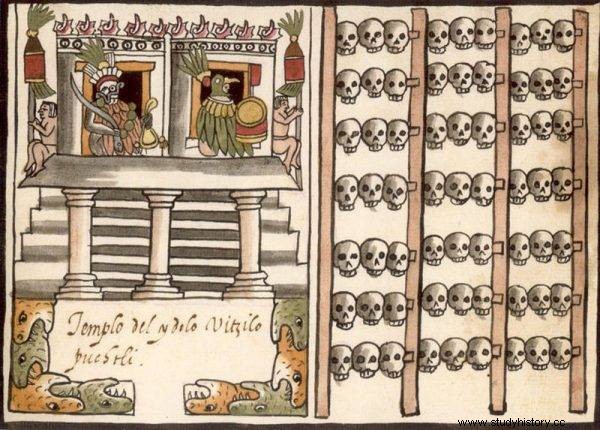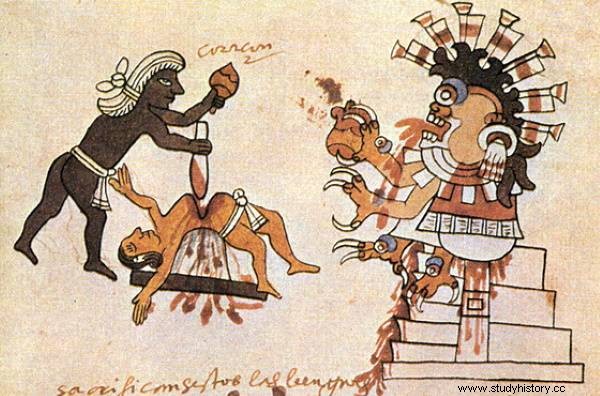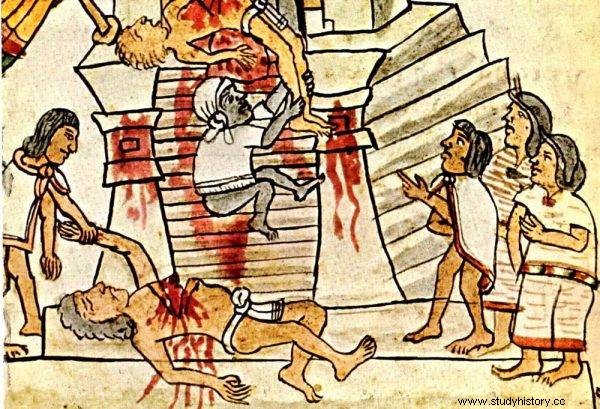The Aztecs did human sacrifice on a really huge scale. Each year they killed thousands of their enemies in honor of the deities. But why did they eat them afterwards?
In this house there were many large pots, jars and jugs full of water in which they cooked the meat of the unfortunate Indians, whom they sacrificed and ate papas [priests] . Near this place of sacrifice, they had many large knives and wooden stumps that are used to slice meat in a slaughterhouse . (…) I have always called this building hell.
In this picturesque way, Bernal Diaz del Castillo, the Spanish conquistador, author of the most famous account of the conquest of Mexico, described his visit to the Aztec temple. Not just any temple, because it belongs to the guardian deity of the Aztecs - Huitzilopochtli. The fact that the people of pre-Columbian Mexico were making human sacrifice on a really enormous scale is not actually under discussion. Some sources indicate that during special ceremonies, such as the dedication of the Great Temple, up to 80,000 prisoners were sacrificed. This number is almost certainly exaggerated. However, anyway, we are talking about thousands of people here, killed each year in honor of the gods. Even more interestingly, some parts of the victims' bodies were eaten afterwards.
Hunger cannibalism?
This is where the question arises:why and for what? An interesting answer to this question was provided by Michael Harner in his 1977 article "The Ecological Basis for Aztec Sacrifice". Well, according to him, eating the bodies of sacrificed prisoners was a way to replenish the protein and fat deficiencies in the Aztec diet . Harner argues (rightly) that Central America lacked herbivorous mammals to domesticate and bred for meat. There remained turkeys, which are less productive in this regard, and dogs, which in turn also need to be fed meat, so they would compete with humans for the same resource. The wild animal population would be insufficient to provide adequate nutrients to these densely populated areas.

photo:Juan de Tovar / public domain The inhabitants of pre-Columbian Mexico sacrificed people on a really enormous scale
Another argument comes from the scale of the sacrifices made. According to the author, it was supposed to be 250,000 people a year, which would be 1% of Central Mexico's population. Human meat would therefore be an essential component of the diet. Moreover, the number of bloody rituals grew as the population of the area increased. The Aztecs and their traditional enemies from Tlaxcallan even fought the so-called "Flower wars". The purpose of these clashes was to win the prisoners for sacrifices. All the elaborate rituals and rankings of warriors, based on the number of enemies they captured, were to justify the need to extract proteins and fats from human flesh.
I don't think so
This is undoubtedly an effective and bold hypothesis, but there are several problems with it. The first and most important is that the people of Central Mexico probably did not suffer from a deficit of proteins and fats at all . The most densely populated areas were on the shores of a vast system of lakes, the largest of which was Texcoco. The lakes provided an abundance of waterfowl, fish and amphibians making them an excellent and readily available source of protein.
In addition, the basis of the Aztec diet was corn and beans, which together provided the right amount of protein. Of course, there have been times with extremely poor harvests. For example, in 1450–54, the famine in the Valley of Mexico forced a villager to sell children for food. However, it was not a chronic condition. Moreover, the center of the empire could count on the supply of food from conquered territories, paying tribute in this form. It is estimated that the corn, beans, amaranth and chia that were brought this way to the Valley of Mexico could feed 60,000-150,000 people a year.

The bodies of the unfortunates sacrificed were not completely eaten.
Another argument that challenges Harner's hypothesis is that usually hostilities were conducted after the harvest, when the granaries were full . This makes little sense if we assume that any prisoners would be a source of high-quality food. It should also be noted that the bodies of the unfortunates sacrificed were not eaten completely. Only legs and arms were eaten during cannibalistic feasts. The bodies were devoured by animals from the royal zoo or dogs, and the heads were placed on a special platform called tzompantli . Again, if the body was a source of protein and fat, it would be better to eat it whole.
A treat for the chosen ones
Aztec society was divided into aristocracy and commoners. As you can easily guess, the parties where human meat was served were attended almost exclusively by aristocrats . Popular warriors could attain this honor only if they distinguished themselves on the battlefield. So most of the human flesh was eaten by people who could count on better nourishment anyway . Harner notes this issue, but says the prospect of a "special meal" was intended to motivate ordinary warriors to become more involved on the battlefield.

Almost exclusively aristocrats attended parties where human meat was served.
I must admit that this argument is far too far from being taken. In addition, children and adolescents are the people who need the most nutrients. And these groups did not practice cannibalism at all. Finally, it is worth noting that Harner is quite comfortable with the numbers regarding the scale of cannibalism and human sacrifice in general. The 250,000 victims he mentions annually are much more than most researchers accept. Generally it is said to be 20,000. And you have to remember that not all bodies were eaten.
Why did the Aztecs make sacrifices?
So what explains making sacrifices on such a scale? Most likely a policy . The POWs sacrificed came from the conquered provinces. Thus, as they were losing their warriors, the risk of rebellion decreased significantly. The sacrifice was also associated with a huge spectacle during which the unfortunates climbed to the top of the pyramid, where the priests tore their hearts out. It all made an impression on the people of Tenochtitlan and the invited guests. It was, you could say, imperial propaganda. A special kind.
